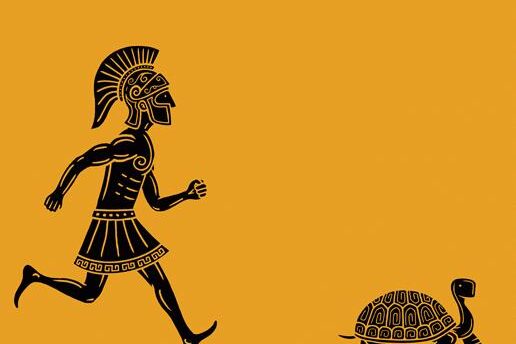
Provoked by Zeno’s Paradoxes
The ancient philosopher’s famous riddles highlighted problems in math and physics that would take millennia to solve.
Paradoxes arise when different ways of thinking about a situation lead to contradictory conclusions. Since nature cannot contain contradictions, physical paradoxes point to flaws in our thinking. They invite us to do better.
Paradoxes have played a glorious role in the history of physics. Young Albert Einstein, at the age of 16, saw that if he could catch up to a light beam he would see things that contradicted the existing laws of physics. Ten years of thinking later, his special theory of relativity showed why it was impossible to catch up with a light beam.
The pre-Socratic philosopher Zeno of Elea, who lived in the 5th century B.C., produced several famous paradoxes concerned with the nature of change and motion. Almost 2,500 years later, Bertrand Russell wrote that “Zeno’s arguments, in some form, have afforded grounds for almost all theories of space and time and infinity which have been constructed from his time to our own.”
Zeno’s paradoxes can be boiled down to three: the paradox of infinity, the paradox of nullity and the paradox of stasis.
Zeno’s story about a race between Achilles and a tortoise nicely illustrates the paradox of infinity. Achilles starts at point A while the tortoise starts ahead, at point B. By the time Achilles gets to B the tortoise has moved on to point C. Rinse, lather, repeat. Each episode takes a finite amount of time, and there are an infinite number of episodes. How does Achilles manage to catch up (in a finite time)?
The paradox of nullity goes as follows. Lines are made from points. But the length of a point is zero, and no matter how many zeros you add together, you still get zero. So how do lines achieve nonzero length?
In both paradoxes the “right” answer is a finite quantity, but Zeno’s analyses suggest infinite time in one case and zero space in the other.
Logically satisfactory answers to those paradoxes only emerged relatively recently. In the 19th century, mathematicians learned how to deal with infinite sums of decreasing terms. The theory shows that when the sum “converges,” there is a well-defined, finite answer. In the 20th century they learned to accommodate the fact that by adding zero enough times you actually can get past zero. This kind of question is treated in an advanced chapter of mathematics called measure theory, which is notoriously tricky and unintuitive.
Zeno’s arrow introduces the paradox of stasis. At every instant an arrow is at one place, and the tip of the arrow, a point, takes up zero distance. No matter how many instants we add, we never achieve a finite distance, so the arrow cannot move. In present-day physics, based on a space-time continuum, the arrow paradox is solved using the same tricky mathematics that resolves the paradox of nullity.
If space and time were both discrete, then the arrow could just hop, at each tick of time, from one position to another. That simpler alternative seems more in tune with our digital age. A movie, after all, is really a series of snapshots.
According to Isaac Newton, “Nature does nothing in vain when less will serve; for Nature is pleased with simplicity and affects not the pomp of superfluous causes.” Why doesn’t it go digital, thus avoiding Zeno’s subtleties? You could say it’s a paradox. Zeno lives.
Originally appeared on April 1, 2021 on The Wall Street Journal website as ‘Provoked by Zeno’s Paradoxes‘
Frank Wilczek is the Herman Feshbach Professor of Physics at MIT, winner of the 2004 Nobel Prize in Physics, and author of the books Fundamentals: Ten Keys to Reality (2021), A Beautiful Question: Finding Nature’s Deep Design (2015), and The Lightness of Being: Mass, Ether, and the Unification of Forces (2009).